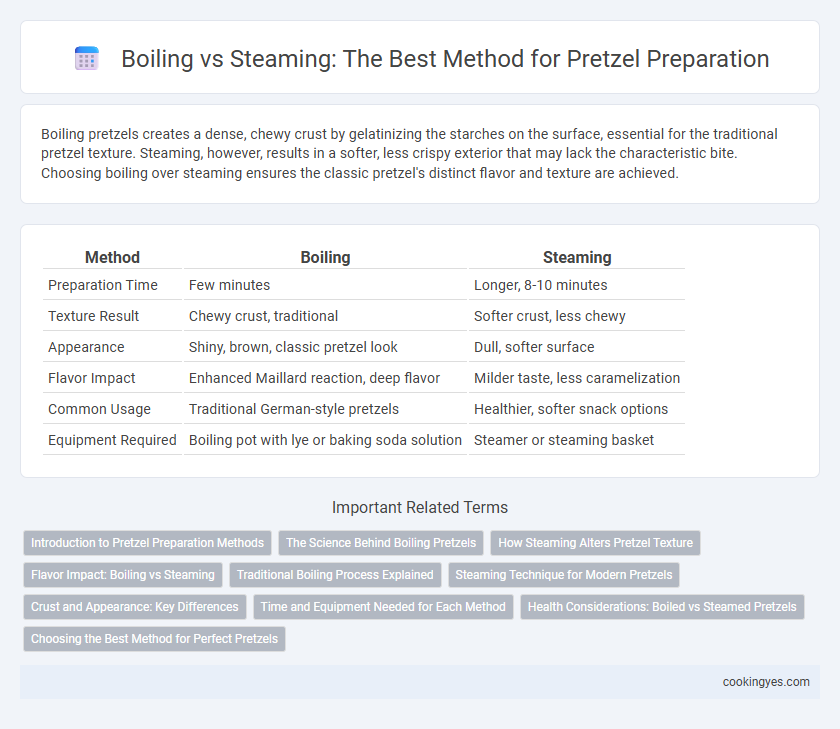Boiling pretzels creates a dense, chewy crust by gelatinizing the starches on the surface, essential for the traditional pretzel texture. Steaming, however, results in a softer, less crispy exterior that may lack the characteristic bite. Choosing boiling over steaming ensures the classic pretzel's distinct flavor and texture are achieved.
Table of Comparison
| Method | Boiling | Steaming |
|---|---|---|
| Preparation Time | Few minutes | Longer, 8-10 minutes |
| Texture Result | Chewy crust, traditional | Softer crust, less chewy |
| Appearance | Shiny, brown, classic pretzel look | Dull, softer surface |
| Flavor Impact | Enhanced Maillard reaction, deep flavor | Milder taste, less caramelization |
| Common Usage | Traditional German-style pretzels | Healthier, softer snack options |
| Equipment Required | Boiling pot with lye or baking soda solution | Steamer or steaming basket |
Introduction to Pretzel Preparation Methods
Boiling is the traditional pretzel preparation method that creates a chewy crust by gelatinizing the dough's surface starches through brief immersion in alkaline water, often baking soda or lye solution. Steaming, an alternative technique, introduces moisture as the pretzels bake, resulting in a softer crust and lighter texture without the distinctive deep brown color of boiled pretzels. Both methods impact the final pretzel's texture, flavor, and appearance, with boiling providing the classic dense chew and characteristic crust while steaming yields a tender bite and subtle crust finish.
The Science Behind Boiling Pretzels
Boiling pretzels in a baking soda solution induces the Maillard reaction, creating a distinctive deep brown crust and chewy texture by altering the dough's surface starches. This alkaline water bath gelatinizes the outer layer, preventing it from rising too much in the oven and results in the characteristic glossy finish. Steaming, in contrast, produces a softer crust and lighter color, lacking the intense flavor and crunch derived from boiling.
How Steaming Alters Pretzel Texture
Steaming pretzels introduces moisture that softens the dough surface, resulting in a chewier, less crusty texture compared to boiling. This method reduces the Maillard reaction, leading to a lighter, less browned crust and a more tender bite. Steamed pretzels often exhibit a fluffier interior, appealing to those who prefer a softer, less traditional pretzel experience.
Flavor Impact: Boiling vs Steaming
Boiling pretzels in a baking soda solution creates a distinctive chewy crust with a deep, slightly tangy flavor due to Maillard reactions. Steaming produces a softer exterior, preserving more delicate dough aromas but lacks the characteristic pretzel crust flavor and texture. The choice between boiling and steaming directly influences the final taste and mouthfeel, with boiling favored for traditional pretzels known for their rich, complex flavor.
Traditional Boiling Process Explained
The traditional boiling process for pretzel preparation involves submerging shaped dough in a boiling baking soda or lye solution, which creates the distinctive chewy crust and deep-brown color after baking. This alkaline bath promotes the Maillard reaction, essential for authentic flavor and texture development in classic soft pretzels. Boiling also helps to set the dough's surface, preventing excessive rising and maintaining the pretzel's characteristic shape.
Steaming Technique for Modern Pretzels
Steaming pretzels during preparation creates a moist environment that enhances dough elasticity and promotes even rising, resulting in a softer, chewier texture preferred in many modern artisanal recipes. This technique preserves the dough's moisture content better than boiling, preventing over-saturation and enabling improved oven spring and a tender crumb. Steaming also encourages a glossy, golden crust by gently setting the surface starches before baking, aligning with contemporary trends in soft pretzel production.
Crust and Appearance: Key Differences
Boiling pretzels in a baking soda solution creates a thick, glossy crust with a deep golden-brown color and signature chewy texture, essential for traditional pretzels. Steaming results in a softer crust with a matte finish and lighter color, often yielding a bread-like appearance rather than the classic pretzel look. The difference in crust formation directly impacts visual appeal and texture, with boiling providing the distinctive crunchy, shiny surface preferred in authentic pretzel preparation.
Time and Equipment Needed for Each Method
Boiling pretzels requires a large pot of water and typically takes about 30 to 60 seconds per batch, effectively creating the characteristic chewy crust through a quick gelatinization process. Steaming pretzels demands specialized steaming equipment and generally requires a longer time, around 5 to 10 minutes, producing a softer texture without the traditional crisp exterior. Choosing between boiling and steaming impacts both preparation time and the texture outcome, with boiling offering a faster method using basic kitchen tools.
Health Considerations: Boiled vs Steamed Pretzels
Boiling pretzels in a baking soda solution creates a distinctive crust and caramelized flavor but may increase sodium content and reduce some heat-sensitive nutrients. Steaming pretzels results in a softer texture and retains more moisture, potentially preserving more vitamins and minerals. Choosing steaming over boiling can be a healthier alternative by minimizing sodium intake while maintaining essential nutrients.
Choosing the Best Method for Perfect Pretzels
Boiling pretzels in a baking soda solution creates a chewy crust with a glossy finish, essential for traditional soft pretzels, while steaming results in a softer, less crusty texture often found in pretzel buns. The choice between boiling and steaming depends on the desired texture: boiling for classic, authentic pretzels with a distinct crust and flavor, steaming for softer, fluffier pretzels suited to sandwich styles. Optimal pretzel preparation favors boiling to achieve the characteristic Maillard reaction that produces the signature taste and appearance.
Boiling vs Steaming for Pretzel Preparation Infographic

 cookingyes.com
cookingyes.com